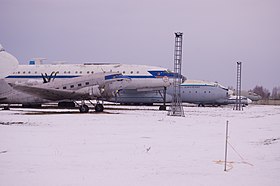Aeroflot flight 112
| Aeroflot flight 112 | |
|---|---|
|
A Lissunow Li-2 in the foreground |
|
| Accident summary | |
| Accident type | Emergency landing after failure of both engines |
| place | 4 km from Derweze Airport , Turkmen SSR |
| date | January 2, 1965 |
| Fatalities | 24 |
| Survivors | 0 |
| Aircraft | |
| Aircraft type | Lissunov Li-2 |
| operator | Aeroflot |
| Mark | CCCP-63842 |
| Departure airport |
Tashauz Airport , Turkmen SSR |
| Stopover |
Derweze Airport (unplanned), Turkmen SSR |
| Destination airport |
Ashgabat Airport , Turkmen SSR |
| Passengers | 22nd |
| crew | 2 |
| Lists of aviation accidents | |
On January 2, 1965, a Lissunow Li-2 had an accident on the second segment of the inner-Soviet scheduled flight Aeroflot flight 111/112 from Ashgabat to Taschauz (today Daşoguz ) and back again, killing all 24 occupants. The incident is to date (July 2020) the most serious aircraft accident in today's Turkmenistan .
Airplane and occupants
The aircraft was a 16-year-old Lissunow Li-2 ( aircraft registration : CCCP-63842 , serial number : 6401 ), which had completed 8758 operating hours up to the accident.
The crew consisted of a flight captain and a first officer . Among the 22 passengers were 21 adults and a child.
Circumstances and course of the accident
On January 1, 1965, one day before the accident, the Li-2 took off from Ashgabat at 13:05 and landed Taschauz at 14:58, before returning to its return flight at around 1538. Because the weather in Ashgabat worsened on the flight, the pilots were instructed at 4:10 p.m. to switch to the alternative airport in Derweze, whereupon they landed at 4:35 p.m. The inmates spent the following night in Derweze. The next morning, January 2, the first officer prepared for take-off, testing the engines and checking the remaining fuel with the help of local airport staff. When the aircraft was on the runway, the local air traffic controller gave take-off clearance , although he had no information about the load, take-off weight or the amount of fuel , which was against the established procedure. The Li-2 then accelerated to a course of 165 ° and then took off at 9:57 a.m. local time , with a visibility of 20 km and a wind of 2 m / s from the direction of 70 °. While still climbing, both engines failed 1–2 minutes after take-off and the aircraft lost altitude without propulsion. Shortly afterwards it crashed, almost without pitching inclination and with a bank angle of 30 ° to the left, at sand dunes 4 km from Derweze Airport and 600 m to the right of the center of the runway and caught fire.
root cause
The investigators could not find any technical defects in the engines that could have led to failure. They found that the Li-2 in Ashgabat had been refueled with 1,236 kg of fuel, which was entered in the flight plan. According to the calculation, the right tank was so empty at the start in Derweze that the fuel would not even have been enough for the climb. However, contrary to the flight manual , the pilots had switched the fuel valve to the right tank and not to the left tank, which is why the engines most likely failed due to a lack of fuel. Hence, the pilots were identified as the main culprits. The persons who planned the flight were found complicit because they had not given clear instructions. This would have included, among other things, regularly checking the fuel consumption in flight, as stated in the Li-2's flight manual.
swell
- Aircraft accident data and report CCCP-63842 on the Aviation Safety Network , accessed April 9, 2019.
- Description of the accident on airdisaster.ru , accessed on April 9, 2019
- Description of the accident on avia.pro , accessed on April 9, 2019
